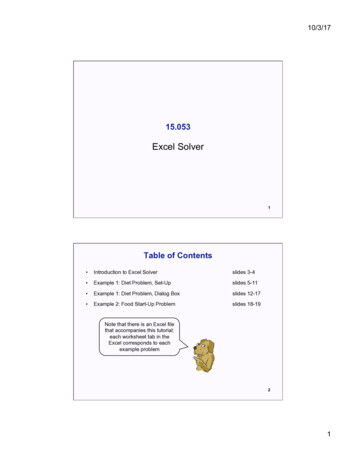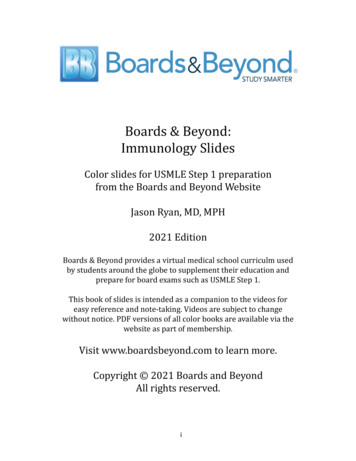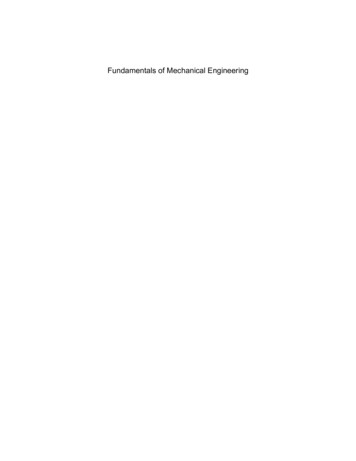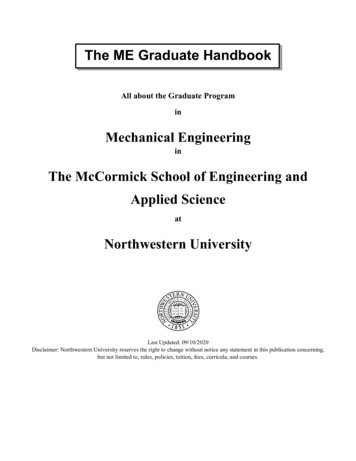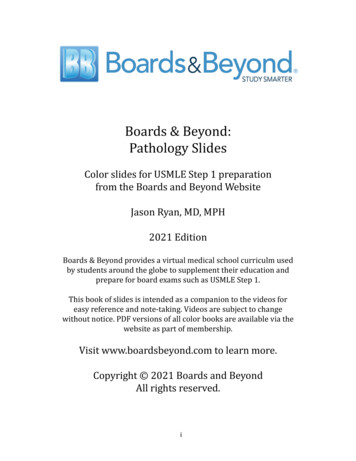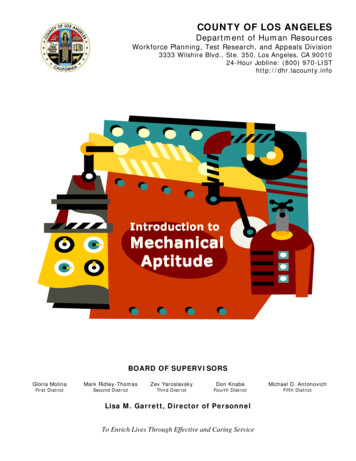
Transcription
Lecture SlidesChapter 10Mechanical Springs 2015 by McGraw-Hill Education. This is proprietary material solely for authorized instructor use. Not authorized for sale or distribution in any manner. This document may not becopied, scanned, duplicated, forwarded, distributed, or posted on a website, in whole or part.
Chapter OutlineShigley’s Mechanical Engineering Design
Mechanical SpringsExert Force Provide flexibility Store or absorb energy Shigley’s Mechanical Engineering Design
Helical Spring Helical coil spring with round wireEquilibrium forces at cut section anywhere in the body of thespring indicates direct shear and torsionFig. 10–1Shigley’s Mechanical Engineering Design
Stresses in Helical Springs Torsional shear and direct shearAdditive (maximum) on inside fiber ofcross-section Substitute terms Fig. 10–1bShigley’s Mechanical Engineering Design
Stresses in Helical SpringsFactor out the torsional stressd 8FD 1 3 2D d Define Spring IndexDefine Shear Stress Correction Factor12C 1Ks 1 2C2CMaximum shear stress for helical springShigley’s Mechanical Engineering Design
Curvature Effect Stress concentration type of effect on inner fiber due to curvatureCan be ignored for static, ductile conditions due to localized coldworkingCan account for effect by replacing Ks with Wahl factor orBergsträsser factor which account for both direct shear andcurvature effectCancelling the curvature effect to isolate the curvature factorShigley’s Mechanical Engineering Design
Deflection of Helical SpringsUse Castigliano’s method to relate force and deflectionFig. 10–1aShigley’s Mechanical Engineering Design
Ends of Compression SpringsFig. 10–2Shigley’s Mechanical Engineering Design
Formulas for Compression Springs With Different EndsTable 10–1Na is the number of active coilsShigley’s Mechanical Engineering Design
Set Removal Set removal or presetting is a process used in manufacturing aspring to induce useful residual stresses.The spring is made longer than needed, then compressed to solidheight, intentionally exceeding the yield strength.This operation sets the spring to the required final free length.Yielding induces residual stresses opposite in direction to thoseinduced in service.10 to 30 percent of the initial free length should be removed.Set removal is not recommended when springs are subject tofatigue.Shigley’s Mechanical Engineering Design
Critical Deflection for Stability Buckling type of instability can occur in compression springswhen the deflection exceeds the critical deflection ycr Leff is the effective slenderness ratio a is the end-condition constant, defined on the next slide C'1 and C'2 are elastic constantsShigley’s Mechanical Engineering Design
End-Condition Constant The a term in Eq. (10–11) is the end-condition constant.It accounts for the way in which the ends of the spring aresupported.Values are given in Table 10–2.Table 10–2Shigley’s Mechanical Engineering Design
Absolute Stability Absolute stability occurs when, in Eq. (10–10),2C2 / eff 1 This results in the condition for absolute stability For steels, this turns out to beShigley’s Mechanical Engineering Design
Some Common Spring Steels Hard-drawn wire (0.60-0.70C) Cheapest general-purpose Use only where life, accuracy, and deflection are not tooimportantOil-tempered wire (0.60-0.70C) General-purpose Heat treated for greater strength and uniformity of properties Often used for larger diameter spring wireMusic wire (0.80-0.95C) Higher carbon for higher strength Best, toughest, and most widely used for small springs Good for fatigueShigley’s Mechanical Engineering Design
Some Common Spring Steels Chrome-vanadium Popular alloy spring steel Higher strengths than plain carbon steels Good for fatigue, shock, and impactChrome-silicon Good for high stresses, long fatigue life, and shockShigley’s Mechanical Engineering Design
Strength of Spring Materials With small wire diameters, strength is a function of diameter.A graph of tensile strength vs. wire diameter is almost a straightline on log-log scale.The equation of this line iswhere A is the intercept and m is the slope.Values of A and m for common spring steels are given in Table10–4.Shigley’s Mechanical Engineering Design
Constants for Estimating Tensile StrengthTable 10–4Shigley’s Mechanical Engineering Design
Estimating Torsional Yield Strength Since helical springs experience shear stress, shear yield strengthis needed.If actual data is not available, estimate from tensile strengthAssume yield strength is between 60-90% of tensile strength0.6Sut Ssy 0.9Sut Assume the distortion energy theory can be employed to relatethe shear strength to the normal strength.Ssy 0.577SyThis results inShigley’s Mechanical Engineering Design
Mechanical Properties of Some Spring Wires (Table 10–5)Shigley’s Mechanical Engineering Design
Maximum Allowable Torsional StressesShigley’s Mechanical Engineering Design
Example 10–1Shigley’s Mechanical Engineering Design
Example 10–1Shigley’s Mechanical Engineering Design
Example 10–1Shigley’s Mechanical Engineering Design
Example 10–1Shigley’s Mechanical Engineering Design
Example 10–1Shigley’s Mechanical Engineering Design
Helical Compression Spring Design for Static Service Limit the design solution space by setting some practical limitsPreferred range for spring index Preferred range for number of active coils Shigley’s Mechanical Engineering Design
Helical Compression Spring Design for Static ServiceTo achieve best linearity of spring constant, preferred to limitoperating force to the central 75% of the force-deflection curvebetween F 0 and F Fs. This limits the maximum operating force to Fmax 7/8 Fs Define fractional overrun to closure as ξ where This leads to Solving the outer equality for ξ, Thus, it is recommended thatξ 1/7 0.143 0.15Shigley’s Mechanical Engineering Design
Summary of Recommended Design Conditions The following design conditions are recommended for helicalcompression spring design for static servicewhere ns is the factor of safety at solid height.Shigley’s Mechanical Engineering Design
Figure of Merit for High Volume Production For high volume production, the figure of merit (fom) may be thecost of the wire.The fom would be proportional to the relative material cost,weight density, and volumeShigley’s Mechanical Engineering Design
Design Flowchart for Static LoadingContinue on next slideShigley’s Mechanical Engineering Design
Design Flowchart for Static LoadingContinued from previous slideShigley’s Mechanical Engineering Design
Design Flowchart for Static LoadingShigley’s Mechanical Engineering Design
Finding Spring Index for As-Wound Branch In the design flowchart, for the branch with free, as-woundcondition, the spring index is found as follows:From Eqs. (10–3) and (10–17), Let Substituting (b) and (c) into (a) yields a quadratic in C. Shigley’s Mechanical Engineering Design
Example 10–2Shigley’s Mechanical Engineering Design
Example 10–2Shigley’s Mechanical Engineering Design
Example 10–2Shigley’s Mechanical Engineering Design
Example 10–2Shigley’s Mechanical Engineering Design
Example 10–2Shigley’s Mechanical Engineering Design
Example 10–3Shigley’s Mechanical Engineering Design
Example 10–3Shigley’s Mechanical Engineering Design
Example 10–3Shigley’s Mechanical Engineering Design
Example 10–3Shigley’s Mechanical Engineering Design
Example 10–3Shigley’s Mechanical Engineering Design
Example 10–3Shigley’s Mechanical Engineering Design
Example 10–3Shigley’s Mechanical Engineering Design
Critical Frequency of Helical SpringsWhen one end of a springis displaced rapidly, awave called a spring surgetravels down the spring. If the other end is fixed,the wave can reflect back. If the wave frequency isnear the natural frequencyof the spring, resonancemay occur resulting inextremely high stresses. Catastrophic failure mayoccur, as shown in thisvalve-spring from an overrevved engine. Fig. 10–4Shigley’s Mechanical Engineering Design
Critical Frequency of Helical Springs The governing equation is the wave equationShigley’s Mechanical Engineering Design
Critical Frequency of Helical Springs The solution to this equation is harmonic and depends on the givenphysical properties as well as the end conditions.The harmonic, natural, frequencies for a spring placed betweentwo flat and parallel plates, in radians per second, are In cycles per second, or hertz, With one end against a flat plate and the other end free,Shigley’s Mechanical Engineering Design
Critical Frequency of Helical Springs The weight of a helical spring is The fundamental critical frequency should be greater than 15 to20 times the frequency of the force or motion of the spring.If necessary, redesign the spring to increase k or decrease W. Shigley’s Mechanical Engineering Design
Fatigue Loading of Helical Compression SpringsZimmerli found that size, material, and tensile strength have noeffect on the endurance limits of spring steels in sizes under 3/8in (10 mm). Testing found the endurance strength components for infinite lifeto be These constant values are used with Gerber or Goodman failurecriteria to find the endurance limit.Shigley’s Mechanical Engineering Design
Fatigue Loading of Helical Compression Springs For example, with an unpeened spring with Ssu 211.5 kpsi, theGerber ordinate intercept for shear, from Eq. (6–42), isFor the Goodman criterion, it would be Sse 47.3 kpsi. Each possible wire size would change the endurance limit sinceSsu is a function of wire size. Shigley’s Mechanical Engineering Design
Fatigue Loading of Helical Compression Springs It has been found that for polished, notch-free, cylindricalspecimens subjected to torsional shear stress, the maximumalternating stress that may be imposed is constant andindependent of the mean stress.Many compression springs approach these conditions.This failure criterion is known as the Sines failure criterion.Shigley’s Mechanical Engineering Design
Torsional Modulus of Rupture The torsional modulus of rupture Ssu will be needed for thefatigue diagram.Lacking test data, the recommended value isShigley’s Mechanical Engineering Design
Stresses for Fatigue Loading From the standard approach, the alternating and midrange forcesare The alternating and midrange stresses areShigley’s Mechanical Engineering Design
Example 10–4Shigley’s Mechanical Engineering Design
Example 10–4Shigley’s Mechanical Engineering Design
Example 10–4Shigley’s Mechanical Engineering Design
Example 10–4Shigley’s Mechanical Engineering Design
Example 10–4Shigley’s Mechanical Engineering Design
Example 10–4Shigley’s Mechanical Engineering Design
Example 10–4Shigley’s Mechanical Engineering Design
Example 10–5Shigley’s Mechanical Engineering Design
Example 10–5Shigley’s Mechanical Engineering Design
Example 10–5Shigley’s Mechanical Engineering Design
Example 10–5Shigley’s Mechanical Engineering Design
Example 10–5Shigley’s Mechanical Engineering Design
Example 10–5Shigley’s Mechanical Engineering Design
Example 10–5Shigley’s Mechanical Engineering Design
Example 10–5Shigley’s Mechanical Engineering Design
Example 10–5Shigley’s Mechanical Engineering Design
Extension Springs Extension springs are similar to compression springs within thebody of the spring.To apply tensile loads, hooks are needed at the ends of thesprings.Some common hook types:Fig. 10–5Shigley’s Mechanical Engineering Design
Stress in the Hook In a typical hook, a critical stress location is at point A, where thereis bending and axial loading. (K)A is a bending stress-correction factor for curvatureFig. 10–6Shigley’s Mechanical Engineering Design
Stress in the Hook Another potentially critical stress location is at point B, wherethere is primarily torsion. (K)B is a stress-correction factor for curvature.Fig. 10–6Shigley’s Mechanical Engineering Design
An Alternate Hook Design This hook design reduces the coil diameter at point A.Fig. 10–6Shigley’s Mechanical Engineering Design
Close-wound Extension Springs Extension springs are often made with coils in contact with oneanother, called close-wound.Including some initial tension in close-wound springs helps holdthe free length more accurately.The load-deflection curve is offset by this initial tension FiFig. 10–7Shigley’s Mechanical Engineering Design
Terminology of Extension Spring Dimensions The free length is measured inside the end hooks. The hooks contribute to the spring rate. This can be handled byobtaining an equivalent number of active coils.Fig. 10–7Shigley’s Mechanical Engineering Design
Initial Tension in Close-Wound Springs Initial tension is createdby twisting the wire as itis wound onto a mandrel.When removed from themandrel, the initialtension is locked inbecause the spring cannotget any shorter.The amount of initialtension that can routinelybe incorporated is shown.The two curves boundingthe preferred range isgiven byFig. 10–7cShigley’s Mechanical Engineering Design
Guidelines for Maximum Allowable Stresses Recommended maximum allowable stresses, corrected forcurvature effect, for static applications is given in Table 10–7.Table 10–7Shigley’s Mechanical Engineering Design
Example 10–6Shigley’s Mechanical Engineering Design
Example 10–6Shigley’s Mechanical Engineering Design
Example 10–6Shigley’s Mechanical Engineering Design
Example 10–6Shigley’s Mechanical Engineering Design
Example 10–6Shigley’s Mechanical Engineering Design
Example 10–6Shigley’s Mechanical Engineering Design
Example 10–7Shigley’s Mechanical Engineering Design
Example 10–7
Example 10–7Shigley’s Mechanical Engineering Design
Example 10–7
Example 10–7Shigley’s Mechanical Engineering Design
Helical Coil Torsion SpringsHelical coil springscan be loaded withtorsional end loads. Special ends are usedto allow a force to beapplied at a distancefrom the coil axis. Usually used over arod to maintainalignment and providebuckling resistance. Fig. 10–8Shigley’s Mechanical Engineering Design
End Locations of Torsion Springs Terminology for locating relative positions of ends is shown.The initial unloaded partial turn in the coil body is given byThe number of body turns Nb will be the full turns plus the initialpartial turn.Fig. 10–9Shigley’s Mechanical Engineering Design
End Locations of Torsion Springs Commercial tolerances on relative end positions is given in Table10–9Shigley’s Mechanical Engineering Design
Stress in Torsion Springs The coil of a torsion spring experiences bending stress (despite thename of the spring).Including a stress-correction factor, the stress in the coil can berepresented byThe stress-correction factor at inner and outer fibers has beenfound analytically for round wire to beKi is always larger, giving the highest stress at the inner fiber. With a bending moment of M Fr, for round wire the bendingstress is Shigley’s Mechanical Engineering Design
Spring Rate for Torsion Springs Angular deflection is commonly expressed in both radians andrevolutions (turns).If a term contains revolutions, the variable will be expressed with aprime sign.The spring rate, if linear, iswhere moment M can be expressed as Fl or Fr.Shigley’s Mechanical Engineering Design
Deflection in the Body of Torsion Springs Use Castigliano’s method to find the deflection in radians in thebody of a torsion spring. Let M Fl Fr, and integrate over the length of the body-coilwire. The force F will deflect through a distance rq. Using I for round wire, and solving for q,Shigley’s Mechanical Engineering Design
Deflection in the Ends of Torsion Springs The deflection in the ends of the spring must be accounted for.The angle subtended by the end deflection is obtained fromstandard cantilever beam approach.Shigley’s Mechanical Engineering Design
Deflection in Torsion Springs The total angular deflection is obtained by combining the bodydeflection and the end deflection.With end lengths of l1 and l2, combining the two deflectionspreviously obtained gives,Shigley’s Mechanical Engineering Design
Equivalent Active Turns The equivalent number of active turns, including the effect of theends, isShigley’s Mechanical Engineering Design
Spring Rate in Torsion Springs The spring rate, in torque per radian The spring rate, in torque per turn To compensate for the effect of friction between the coils and anarbor, tests show that the 10.2 should be increased to 10.8. Expressing Eq. (10–47) in revolutions, and applying the samecorrection for friction, gives the total angular deflection asShigley’s Mechanical Engineering Design
Decrease of Inside Diameter A torsion spring under load will experience a change in coildiameter.If the spring is over a pin, the inside diameter of the coil must notbe allowed to decrease to the pin diameter.The angular deflection of the body of the coil, extracted from thetotal deflection in Eq. (10–52), is The new helix diameter D' of a deflected coil is The new inside diameter isShigley’s Mechanical Engineering Design
Decrease of Inside Diameter The diametral clearance D between the body coil and the pin ofdiameter Dp is Solving for Nb, This gives the number of body turns necessary to assure aspecified diametral clearance.Shigley’s Mechanical Engineering Design
Static Strength for Torsion Springs To obtain normal yield strengths for spring wires loaded inbending, divide values given for torsion in Table 10–6 by 0.577(distortion energy theory). This givesShigley’s Mechanical Engineering Design
Fatigue Strength for Torsion Springs The Sines method and Zimmerli data were only for torsionalstress, so are not applicable.Lacking better data for endurance limit in bending, use Table 10–10, from Associated Spring for torsion springs with repeated load,to obtain recommended maximum bending stress Sr.Shigley’s Mechanical Engineering Design
Fatigue Strength for Torsion Springs Next, apply the Gerber criterion to obtain the endurance limit.Note that repeated loading is assumed.This accounts for corrections for size, surface finish, and type ofloading, but not for temperature or miscellaneous effects.Shigley’s Mechanical Engineering Design
Fatigue Factor of Safety for Torsion Springs Applying the Gerber criterion as usual from Table 6–7, with theslope of the load line r Ma/Mm, Or, finding nf directly using Table 6–7,Shigley’s Mechanical Engineering Design
Example 10–8Fig. 10–10Shigley’s Mechanical Engineering Design
Example 10–8Shigley’s Mechanical Engineering Design
Example 10–8Shigley’s Mechanical Engineering Design
Example 10–8Shigley’s Mechanical Engineering Design
Example 10–8Shigley’s Mechanical Engineering Design
Example 10–8Shigley’s Mechanical Engineering Design
Example 10–8Shigley’s Mechanical Engineering Design
Belleville Springs The Bellevillespring is a coneddisk spring withunique propertiesIt has a non-linearspring constantWith h/t 2.83, theS curve can beuseful for snapacting mechanismsFor 1.41 h/t 2.1the flat centralportion providesconstant load for aconsiderabledeflection rangeFig. 10–11Shigley’s Mechanical Engineering Design
Constant-Force Springs The extension spring shown is made of slightly curved strip steel,not flat.The fore required to uncoil it remains constant.Known as a constant-force spring.Fig. 10–12Shigley’s Mechanical Engineering Design
Conical SpringA conical spring is wound in the shape of a cone. Most are compression springs, made with round wire. The principal advantage is that the solid height is only a singlewire diameter. Shigley’s Mechanical Engineering Design
Volute SpringA volute spring is a conical spring made from a wide, thin strip, or“flat”, of material wound on the flat so that the coils fit inside oneanother. Since the coils do not stack on each other, the solid height is the widthof the strip. A variable-spring scale is obtained by permitting the coils to contact thesupport. As deflection increases (in compression), the number of active coilsdecreases. Fig. 10–13aShigley’s Mechanical Engineering Design
Constant-Stress Cantilever Spring A uniform-section cantilever spring madefrom flat stock has stress which isproportional to the distance x. It is often economical to proportion thewidth b to obtain uniform stress,independent of x.Fig. 10–13bShigley’s Mechanical Engineering Design
Constant-Stress Cantilever Spring For a rectangular section, I/c bh2/6.Combining with Eq. (a), Solving for b, Since b is linearly related to x, the width bo atthe base is Fig. 10–13bShigley’s Mechanical Engineering Design
Constant-Stress Cantilever Spring Apply Castigliano’s method to obtaindeflection and spring constant equations.The width is a function of x,Integrating Castigliano’s deflection equationwith M and I both functions of x,Fig. 10–13b Thus, the spring constant, k F/y, isShigley’s Mechanical Engineering Design
Set Removal Set removal or presetting is a process used in manufacturing a spring to induce useful residual stresses. The spring is made longer than needed, then compressed to solid height, intentionally exceeding the yield strength. This operation sets the spring to the required final free length. Yielding



